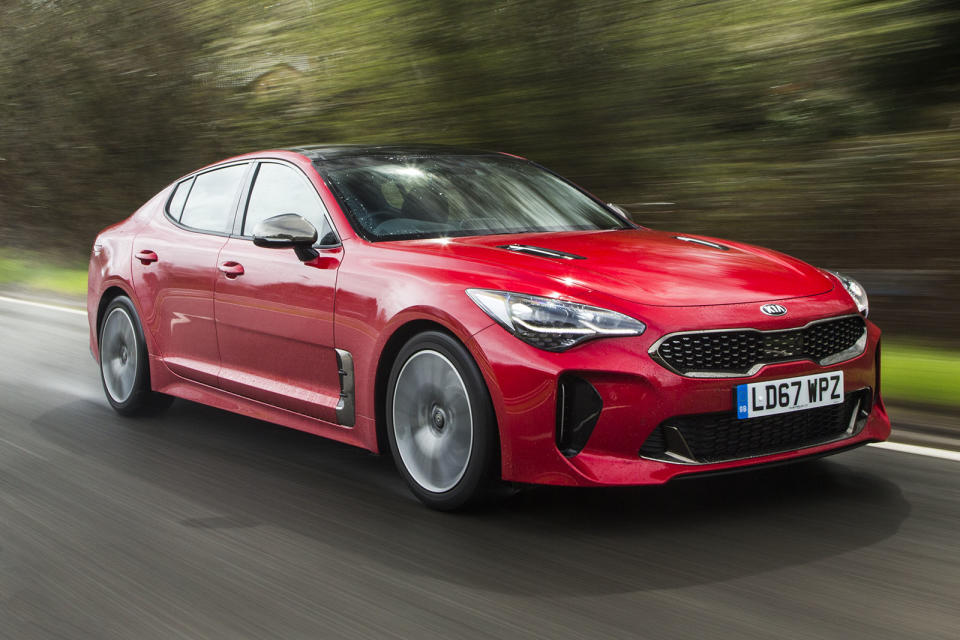Kia Stinger

The Kia Stinger is proof positive that the brand is a dramatically different brand from the one Kia was only a few years ago. Gone are the days when producing cheap and not particularly cheerful hatchbacks and SUVs was the South Korean manufacturer’s raison d’être.
This brand repositioning is in no small part thanks to a step change in its approach to car design, a shift brought about by the likes of Kia design boss Peter Schreyer and European design chief Gregory Guillaume, as well as a more fastidious approach to improving the perceived quality of its vehicles.
And when you arrive at the subject of this week’s road test, a new, third element in this evolutionary process becomes evident.
Not only does this striking grand tourer double down on the aforementioned characteristics of style and quality, but with a rearwheel-drive platform it shows Kia also wants to be taken seriously as a manufacturer of impressively engineered, engaging driver’s cars.
With so much riding on its success as a builder of this next step of Kia’s brand, the Stinger understandably faced a lengthy gestation period. Six years passed between the unveiling of its forerunner, the Kia GT Concept, at the 2011 Frankfurt motor show and the premiere of the finished product at the Detroit show last year.
During that time, Kia hired Albert Biermann, formerly of BMW M division fame, to lead the Stinger’s test and high-performance development regime, and spent hours honing its new flagship on the gruelling Nürburgring Nordschleife.
There’s no denying the Stinger is a brazen statement of intent, particularly when you consider the fact that it’s the first time the manufacturer has put a model into production with the knowledge that it likely won’t turn a profit.
Has the Stinger’s execution matched the rhetoric behind its development, though? Let’s find out.
Kia Stinger design & styling
Three flavours of Stinger are available. Crowning the range is the GT S, which packs a 3.3-litre, 365bhp twin-turbocharged V6 under its bonnet, while a humbler 197bhp 2.2-litre diesel is also available.
The third variant – and the subject of this test – is the entry-level petrol model, which is powered by a 2.0-litre, four-cylinder turbocharged engine.
This longitudinally mounted T-GDi (for turbocharged gasoline direct injection) powerplant is from Kia’s ‘Theta II’ family of engines. It develops 244bhp at 6200rpm and 260lb ft between 1400rpm and 3500rpm. Power is sent to the rear wheels via an electronic eight-speed automatic transmission and a limited-slip differential.
As has increasingly become common practice in this age of engine downsizing and turbocharging, Kia has also employed what it calls an ‘active sound system’ to pipe an enhanced version of the four-cylinder’s engine note into the cabin.
This Stinger’s 18in alloys are shod in 225/45 R18 ContiSport Contact 5 tyres and are suspended by MacPherson struts at the front axle, and a multi-link arrangement at the rear.
Our GT-Line S model is equipped with passive dampers, but the flagship GT S makes use of an adaptive damping system that is controlled via the car’s electronic Drive Mode Selector.
At 4830mm in length, the Stinger is longer than both an Audi A5 Sportback and a BMW 4 Series Gran Coupé, which measure 4733mm and 4640mm respectively.
Despite its size, it’s arguably the most elegantly styled of the three, with its expansive bonnet, long wheelbase and sloping roofline lending it an evocative appearance.
It’s quite unlike any other Kia that’s gone on sale in the UK, and it attracts attention, even more so when people realise which brand’s name is affixed to its nose.
]]>

 Yahoo Autos
Yahoo Autos 